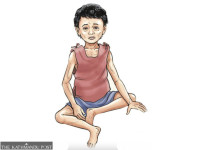Health
A million children go ‘missing’ from health data
Fall in children eligible for Vitamin A raises doubts about accuracy of figures.
Arjun Poudel
Until around two years ago, 3.2 million under-five children were estimated to be eligible for Vitamin A supplementation and deworming tablets. Health authorities used to supply the tablets through nationwide campaigns at health facilities across the country.
However, the national census report unveiled by the National Statistic Office two years ago revised the number of targeted children to around 2.2 million.
Public health experts are concerned as coverage rates for most health programmes including immunisation and Vitamin A supplementation were 85 to over 90 percent in the past, and stayed similarly high even after the decline in the target population.
“Data on children is not based on our own estimation but derived from the population census,” said Lila Bikram Thapa, chief of the Nutrition Section at the Family Welfare Division under the Department of Health Services. “The number of children has declined due to the decline in overall fertility.”
The Ministry of Health and Population launches a nationwide Vitamin A supplementation and deworming campaign twice every year. This year’s campaign will be held on Thursday and Friday (November 6-7). During the campaign, around 2.2 million children from six months to 59 months will get Vitamin A supplementation. Of them, around 1.9 million children between 12 months and 59 months will be given deworming tablets as well.
Public health experts say that it is understandable for the number of children to decline in line with the declining fertility rate—and everyone is aware of the decline in fertility. However, they said that a decline of around one million children in a single year is impossible.
They guess that either health authorities launched campaigns in the past based on wrong estimates and reported inaccurate coverage rates, or a large number of children have been missing from the programmes all along.
“When we did not have the estimated number of children in the country, to whom did we administer vaccines in the past?” questioned Dr Shyam Raj Upreti, former director general of the Department of Health Services.
“The two things cannot happen simultaneously—either we have been manipulating data of the target population and presenting wrong figures, or a large number of children are being excluded from essential services.”
Experts say a decline of one million children in a year is a serious concern. As it also touches on the country’s demography, government agencies and policymakers must discuss the issue and offer clarification.
“If the decline is accurate, what is our policy on demography, and how many children will not be born in the next five to 10 years?” questioned Dr Yasho Vardhan Pradhan, another former director general at the Department of Health Services. “If not, who were the children the government had been serving?”
Officials at the Health Ministry said that data of the target population is sometimes manipulated to match the amount of vitamins tablets and other supplies they have bought.
“Sometimes data is manipulated to secure more funds from aid agencies,” said an official asking not to be named. “Data on HIV, malaria, and other programmes were manipulated in the past. When aid budgets declined, the estimated number of affected population automatically dropped. Similarly, if commodities [medicines, supplies] were purchased in large quantities without knowing the actual number of targeted population, in that case too there is a tendency to raise the estimated population.”
Nepal experienced a population growth of 0.92 percent per annum over the past decade, according to officials.
The growth rate has declined due to various factors, including internal and external migration, late marriage, rise in literacy rates, high unemployment, exorbitant child care cost, among other reasons, experts say.
“If the birthrate has declined alarmingly, this will lead to a topsy-turvy population pyramid, with more elderly people than young population,” said Dr Padam Bahadur Chand, former chief of the Policy Planning and International Cooperation Division at the Health Ministry. “What is happening? Authorities must explain to the public.”




 6.12°C Kathmandu
6.12°C Kathmandu














